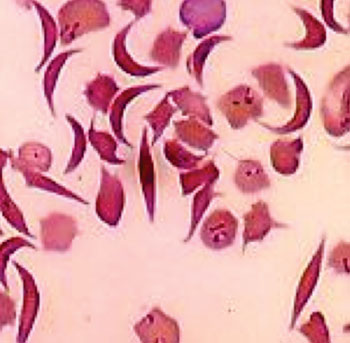Novel Approach Could Make Bone Marrow Transplants Safer
By LabMedica International staff writers
Posted on 23 Jun 2016
Treatment has been developed for bone marrow, via blood stem cell, transplantation safer and, as a result, more widely available to the millions of people living with blood disorders like sickle cell anemia, thalassemia, and acquired immune deficiency syndrome (AIDS).Posted on 23 Jun 2016
Autologous hematopoietic stem cell transplantation (HSCT) using genetically corrected cells would avoid the risk of graft-versus-host disease (GVHD), but the genotoxicity of conditioning remains a substantial barrier to the development of this approach.

Image: A photomicrograph of sickle-shape red blood cells from a patient with sickle cell disease (Photo courtesy of the CDC).
Scientists at the Harvard Stem Cell Institute (Cambridge, MA, USA) and their colleagues have developed a non-toxic transplantation procedure using antibodies to specifically target blood stem cells; an approach they hope will make blood stem cell transplants for these patients far less toxic. Unlike chemotherapy and radiation, which indiscriminately damage cells and tissues, healthy or otherwise, the CD45-targeting antibodies leave the thymus and the bone marrow, environments critical to the formation of T-cells and innate immune cells, unharmed. Animals receiving the antibody treatment were able to withstand infection that was lethal to mice treated with radiation. Currently, infections after transplant are common and may be severe, causing death in a substantial number of people.
Animals that received the antibody treatment had a broad ten-day window within which they could accept a bone marrow transplant, and individuals that did not receive a bone marrow transplant were able to fully recover without adverse effects. Furthermore, mice suffering from sickle cell anemia were successfully transplanted using the antibody method and cured of their anemia. Should the same hold true for humans, what amounts to months of recovery in a hospital bed may be replaced by an outpatient procedure, and a failed transplant would not be fatal.
A single dose of the immunotoxin, CD45–saporin (SAP), enabled efficient greater than 90% engraftment of donor cells and full correction of a sickle-cell anemia model. In contrast to irradiation, CD45–SAP completely avoided neutropenia and anemia, spared bone marrow and thymic niches, enabling rapid recovery of T and B cells, preserved anti-fungal immunity, and had minimal overall toxicity.
David Scadden, MD, a Professor of Medicine and senior author of the study said, “If this approach works in humans, it will really change the conversation that providers have with patients, especially for those who have these underlying genetic disorders and for who the new gene-editing and gene therapy techniques are being developed. It brings precision medicine into the area of transplant in a way that has not been there and is needed.” The study was published on June 6, 2016, in the journal Nature Biotechnology.
Related Links:
Harvard Stem Cell Institute














